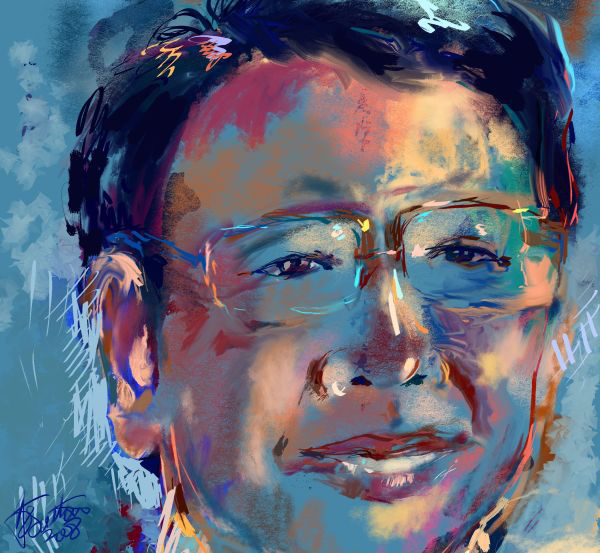In this webinar I shared an expressive approach to painting working from two different sources of inspiration: (1) a photographic source and (2) from direct observation of life. I shared a workflow that starts loose and rough, that builds on a foundation of shapes and light/dark contrasts, and develops a selective focus to lead the eye and visually tell a story.
I used the brand new and fabulous Wacom One Creative Pen Display with Corel Painter 2020 on a Macintosh (it also works fine on a PC).

This painting is based on a photograph I took of musician Robert Dehlinger playing in his Alpha Rhythm Kings band at Club Deluxe in San Francisco. I used an iMac computer with Corel Painter 2020 software and a Wacom Intuos Pro pen tablet.
I’ll use this page to add links and address any questions that arise during the webinar and also post a link to the recording on Wacom’s YouTube channel).
Wacom Preferences and Express Keys Settings
During the webinar I was asked about my Wacom Express Keys settings. Please click here for a full summary of the Wacom Preferences and Express keys settings that I use with Corel Painter 2020 and the Wacom Intuos Pro pen tablet.. I recommend you regularly check for updated Wacom drivers (go to Updates in the Wacom Desktop Center). Then in the Wacom Tablet Control panel (Apple Menu / Systems Preferences/Wacom on a Mac, search in Start Menu for Wacom on a PC) I start by setting the Tool / Functions / Grip Pen and Art Pen two-function button with the lower button (nearest pen tip) set to Modifier / Opt+Cmd (Mac) / Alt+Ctrl (PC) which is the shortcut for changing brush size as you paint, and the upper button (furthest from pen tip) set to Control (Mac) or Right Click (PC) which is the shortcut for accessing a pop-up menu with the current brush category variants. After doing that go to the Tool / Functions / ExpressKeys and set the following:
-
Clone Color – Keystroke / u
-
Tracing Paper – Keystroke / Cmd+T (Mac) / Ctrl+T (PC)
-
Floating Color Palette – Keystroke / Option+Command+2 (Mac) / Alt+Ctrl+2 (PC)
-
Eye Dropper – Modifier / Opt (Mac) / Alt (PC)
-
Hide/Show Palettes – Keystroke / Tab
-
Zoom to Fit – Keystroke / Cmd+0 (Mac) / Ctrl+0 (PC)
-
Iterative Save – Keystroke / Opt+Cmd+S (Mac) / Alt+Ctrl+S (PC)
-
Grabber Hand – Keystroke / Space Bar
Then I set all the Tool / Functions / Touch Ring options to be Auto Scroll / Zoom. I leave the Application / All. You may find you need to reprogram the Quick Switch shortcut, Opt+Cmd+Q (Mac) / Alt+Ctrl+Q (PC), via Corel Painter 2020 (Mac) or Help (PC) / Preferences / Customize Keys / Application Menus / Window / Layout / Quick Switch / Toggle Layout. These are all merely suggestions I share. I recommend you program whatever suits you best.
If you’re interested in the early days of Wacom and Painter, here are some links to follow:
Click here to view a PDF excerpt from Ric Holland’s Art of Making Marks, Masahiko Yamada, Wacom’s President & CEO at the time of the article (2011), talks about the history of the Wacom pen tablet and his vision for the future.
In honor of the 20th anniversary (in 2011) of Painter I asked Mark Zimmer, co-inventor of Painter, to share some stories about the origins of Painter, the phenomenal painting program that has transformed the lives of hundreds of thousands of artists around the world. Click here to download the PDF of this article.
Also read Mark Zimmer’s fascinating blog on the origins of Painter and the Paint Can.


Leave your Comment: